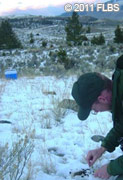Mapping disease spread corridors in the Northern Rocky Mountains using both host and parasite DNA markers (see also III).

Summary:

Infectious diseases are a serious threat to wildlife populations worldwide, including those in national parks and nature reserves where agricultural operations, development, and recreation are fragmenting habitat and increasing interactions between wildlife, domestic animals, and humans. The spread of infectious diseases and parasites is of particular concern in the Greater Yellowstone Area (GYA), which supports large herds of wild ungulates and livestock. The high diversity, density, and co-mingling rates of ungulates in this area could facilitate the rapid emergence and spread of infectious diseases such as brucellosis, yersiniosis, chronic wasting disease, and Johne's disease, with escalating disease threats to livestock and people along the public/private land interface.

A critical need is for information on disease and parasite transmission pathways among populations and between species across complex landscapes of the GYA and Northern Rocky Mountains, which will help develop feasible strategies to minimize the adverse conservation, economic, and social effects of diseases. We address this need by identifying DNA markers from parasite propagules (e.g., shed in ungulate feces) that can be used to non-invasively identify, track, and map parasite and disease transmission routes across the GYA using landscape genetic approaches. Analyses of DNA markers from microparasites (e.g., viruses, bacteria) and macroparasites (e.g., helminths) can help determine the rates and routes of movement and disease spread. We study parasite species that are taxonomically distinct (virus, bacteria, helminth), but share common environmental transmission mechanisms that may enable their spread among species and across large geographical areas without direct host-to-host contact. We study parasites with different life histories to test hypotheses about how life history affects transmission parameters.
This research will help understand the evolution and ecology of infectious disease. It will also help managers control of disease transmission (e.g. by targeting monitoring and hunting efforts).
Collaborators:
Claudia Almendra (U. of Portugal), Neil Anderson (Montana Department of Fish Wildlife and Parks), A. Beja-Pereira (U. of Portugal), Steve Cain (Grant Teton National Park), Paul Cross (USGS), Hank Edwards (Wyoming Fish and Game), Vanessa Ezenwa (U. of Montana), Marty Kardos (U. of Montana, PhD student), Mike O'Brien & Dan Bingham (U. of Montana, MS students), Rick Wallen (Yellowstone National Park) and P.J. White (Yellowstone National Park)
Publications:
- Archie, E.A., G. Luikart, and V. Ezenwa. 2009. Infecting epidemiology with genetics: A new frontier in disease ecology. Trends in Ecology and Evolution, 24:21-30.
- Beja-Pereira, A., B.J. Bricker, S. Chen, C. Almendra, P.J. White, and G. Luikart. 2009. DNA genotyping suggests recent brucellosis outbreaks near Yellowstone National Park originate from elk. Journal of Wildlife Diseases. 45:1174-1177.
- Cross et al. Disease in the 'New West': Effects of changing elk demography on brucellosis dynamics. In press.
- Ferreira, A.C., C. Almendra, R. Cardoso, M.S. Pereira, A. Beja-Pereira, G. Luikart, and M.I.C. de Sá Development and evaluation of a selective medium for improved isolation of Brucella suis. In review.
- Gardipee, F.M, R.L. Wallen, M.P. O'Brien, S. Cain, G. Luikart, and F.W. Allendorf. Strong substructure among Greater Yellowstone Area bison revealed by mitochondrial DNA from fecal samples. MS in prep.
- Hand B.K., S. Chen, A. Beja-Pereira, P. Cross, P.J. White, M. Kardos, H. Edwards, M. Kauffman, B. Garrett, K. Hamlin, M. Schwartz, M. Ebinger, A. Middleton, B. Garrott, N. Anderson, Peter Zager, and G. Luikart. Limited female gene flow among elk herds across the Greater Yellowstone Ecosystem revealed by mitochondrial DNA. In prep.
- See W., Edwards H, Almendra C, M. Kardos, Lowell J, Wallen R., Cain S., & Holben B., Luikart G. Yersinia enterocolitica: an unlikely cause of positive brucellosis tests in greater Yellowstone ecosystem bison. Journal of Wildlife Diseases. Accepted pending minor revision.
